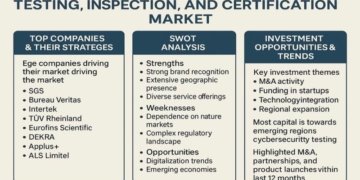According to a new report published by Allied Market Research, titled, “RFID Tags Market by Type, Frequency, Application: Global Opportunity Analysis and Industry Forecast, 2023-2032”, the RFID tags market was valued at $5.9 billion in 2022, and is estimated to reach $15 billion by 2032, growing at a CAGR of 9.9% from 2023 to 2032.
Download Research Report Sample & TOC :
https://www.alliedmarketresearch.com/request-sample/A09889
Radio frequency identification tags are a tracking system used for asset recognition using digital barcode technology. The tags use an antennae, microchip or integrated circuit to send and receive data.
The swift adoption of RFID technology in sectors like manufacturing and logistics significantly contributes to the expansion of the RFID tags market. These industries heavily depend on the precise tracking and administration of assets. RFID asset tags offer an exceedingly effective solution, delivering real-time visibility of merchandise throughout the entire supply chain. Such immediate monitoring is imperative for enhancing process efficiency, elevating productivity, and cutting operational expenses. In the manufacturing domain, RFID tags are vital for overseeing both components and final products, thereby fortifying inventory control and ensuring top-notch quality management. These markings significantly enhance the effectiveness in monitoring consignments and result in more precise deliveries leading to lower risks of loss or mislocation within the logistics sector. In addition to streamlining operations, the involvement of RFID technology in these areas is also very important for their continued growth and advancement on the RFID tag market.
However, the performance of RFID tags can be significantly affected by environmental factors, leading to challenges in certain settings. For instance, metal interference can disrupt radio wave transmission, which is essential for RFID functioning, particularly in metal-rich environments. The presence of liquids, especially water, can absorb radio waves, impacting tag performance in moist or liquid-rich areas. Additionally, extreme temperatures can damage the electronic components of RFID tags or shorten their battery life. To combat these issues, specialized and robust RFID solutions are often required, which can be more complex and costly. This requirement for advanced RFID development to withstand everyday challenges makes the design and cost of RFID products more complicated.
Request For Customization @
https://www.alliedmarketresearch.com/request-for-customization/A09889
When sensors are added to RFID labels, it represents a big advancement in the RFID label industry. This development makes RFID labels able to see and follow things and also gather and share extra information like temperature, air pressure, and moisture levels. This is really helpful in industries like logistics and supply chain management, where it’s important to keep an eye on items, especially those that can spoil quickly or sensitive health-related products, while they’re being shipped.
RFID tags with sensors can also give real-time updates on how machines are doing in manufacturing, making it easier to keep them working well. In agriculture, these labels can even sense environmental factors, which helps with managing crops. When these sensing abilities are added to RFID labels, they become powerful tools for collecting and understanding data. This leads to more advanced monitoring and decision-making, which can help expand markets and drive technological progress.
RFID tags market size has grown significantly in recent years, owing to an increase in demand across a variety of sectors. According to a recent RFID tags market report, the sector has undergone spectacular growth, with a significant gain in market share among major competitors. This increase may be attributed to the ever-increasing need for better inventory management, increased supply chain visibility, and improved asset monitoring systems.
The RFID sector has been gaining substantial traction in the technological sphere. The RFID tags market size is quickly developing, indicating the growing demand for this revolutionary RFID tracking system and identifying technology. Experts are actively watching the industry’s performance and progress in the current RFID tags market analysis. RFID tags marketplace percentage is being fought over by key competitors that are searching for for supremacy on this competitive landscape. Despite those elements, RFID tags market growth is strong, driven by a growing requirement for powerful stock control and supply chain optimisation.To live earlier of the competition, industry stakeholders must stay up to date on the most latest RFID tags marketplace inclinations, converting their methods to in form the converting desires of a continuously converting RFID market.
Inquiry Before Buying :
https://www.alliedmarketresearch.com/purchase-enquiry/A09889
The RFID tags market is segmented on the basis of type, frequency, application, and region. By type, the market is bifurcated into active tags and passive tags. By frequency, the market is divided into low frequency, high frequency, and ultra high frequency. As per application, the RFID tags industry is fragmented into agriculture, animal tracking, commercial, healthcare, logistic and supply chain, retail, security and control, transportation, and others. Region wise, the market is analyzed across North America (the U.S., Canada, and Mexico), Europe (the UK, Germany, France, Italy, and rest of Europe), Asia-Pacific (China, Japan, India, South Korea, and rest of Asia-Pacific), and LAMEA (Latin America, Middle East, and Africa).
Key findings of the study
In 2022, the passive tags sector dominated the market in type phrases, with the highest sales of $3,790.37 million. It is expected to expand significantly, reaching an anticipated $8,076.95 million by 2032, with a compound annual growth rate of 7.98%.
The ultra-high frequency sector led the RFID tags market share in terms of revenue, producing $2,544.92 million in 2022. It is expected to rise at a compound annual growth rate of 10.24% to $6,661.75 million by 2032.
In terms of revenue, the security and access control segment led the market in 2022, contributing $1,341.57 million. It is predicted to rise at a compound yearly growth rate of 6.56% to $2,511.92 million by 2032.
According to the RFID tags market trends in terms of regional contribution, North America topped the market with a revenue of $2,090.57 million in 2022. The market of this region is projected to expand to $4,564.53 million by 2032, with a CAGR of 8.25%.
The RFID tags market key players profiled in the report include Alien Technology Corporation, Avery Dennison Corporation, GAO RFID Incorporated, HID Global Corporation (Assa Abloy), Honeywell International Inc., Identiv, Inc., Impinj, Inc., Invengo Information Technology Co. Ltd., NXP Semiconductors N.V., and Zebra Technologies Corp. The market players have adopted various strategies, such as product launches, acquisitions, partnerships, investments, geographical expansion, and product upgrade/development strategies to expand their foothold in the RFID tags industry.
Report Overview: https://www.alliedmarketresearch.com/request-sample/A09889
Contact:
David Correa
1209 Orange Street,
Corporation Trust Center,
Wilmington, New Castle,
Delaware 19801 USA.
Int’l: +1-503-894-6022
Toll Free: +1-800-792-5285
Fax: +1-800-792-5285
help@alliedmarketresearch.com
Web:https://www.alliedmarketresearch.com
About Us:
Allied Market Research (AMR) is a full-service market research and business-consulting wing of Allied Analytics LLP based in Wilmington, Delaware. Allied Market Research provides global enterprises as well as medium and small businesses with unmatched quality of “Market Research Reports” and “Business Intelligence Solutions.” AMR has a targeted view to provide business insights and consulting to assist its clients to make strategic business decisions and achieve sustainable growth in their respective market domain.
We are in professional corporate relations with various companies, and this helps us in digging out market data that helps us generate accurate research data tables and confirms utmost accuracy in our market forecasting. Each and every data presented in the reports published by us is extracted through primary interviews with top officials from leading companies of domain concerned. Our secondary data procurement methodology includes deep online and offline research and discussion with knowledgeable professionals and analysts in the industry.
This release was published on openPR.


















